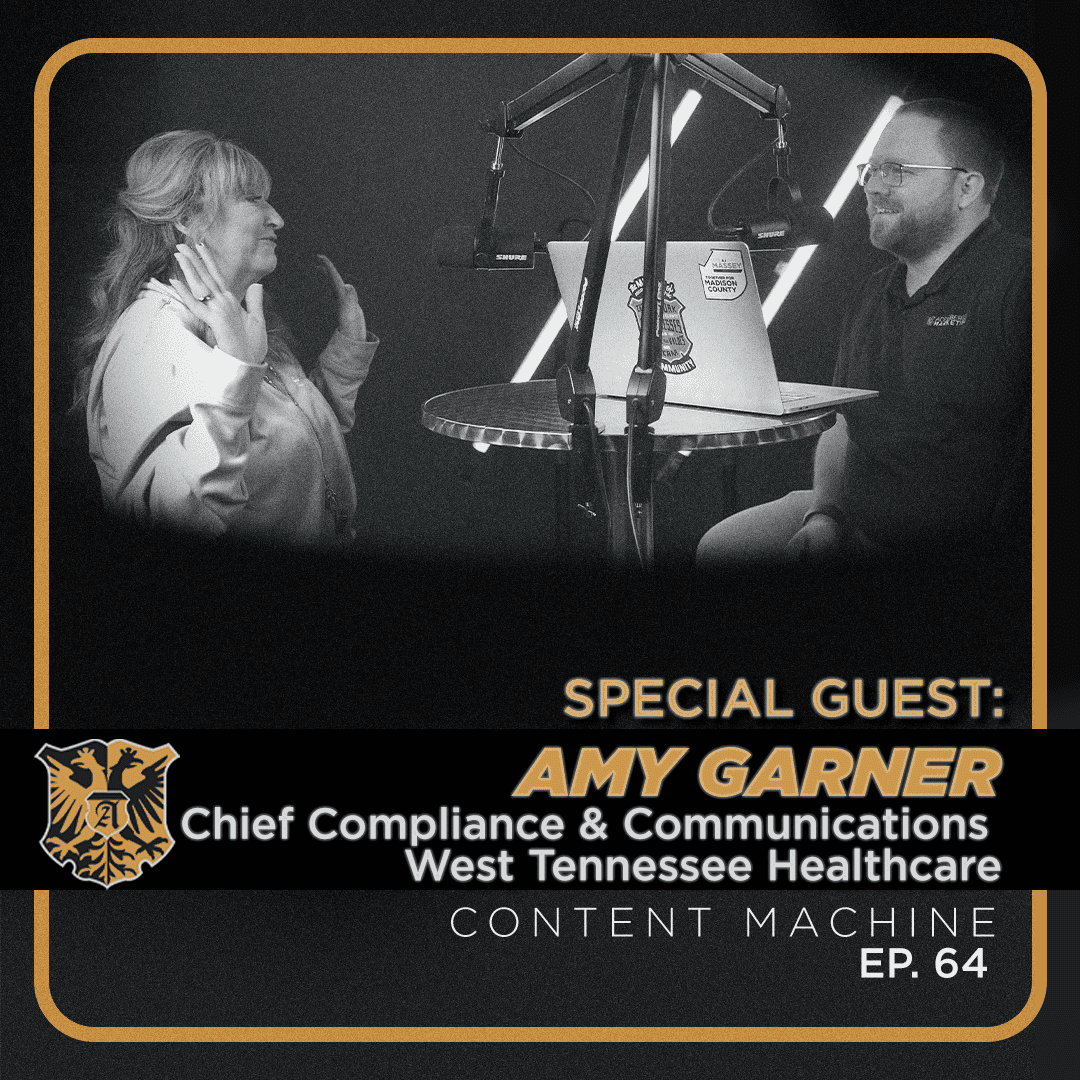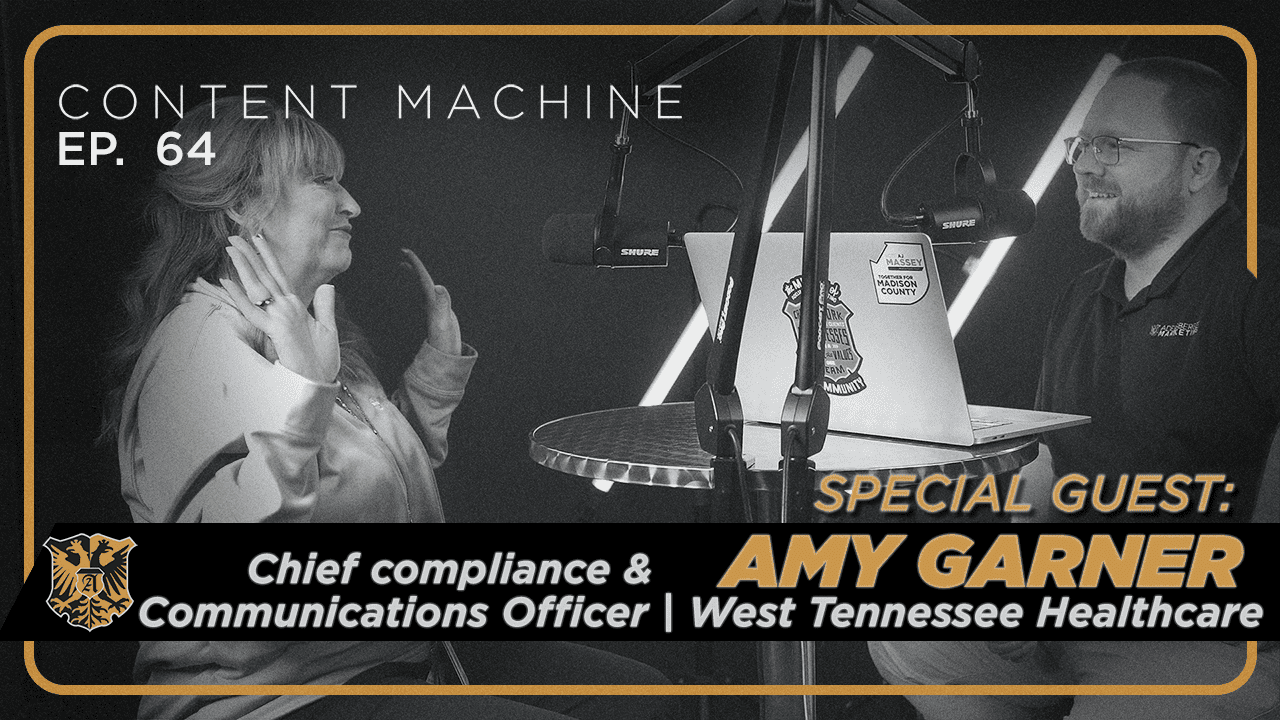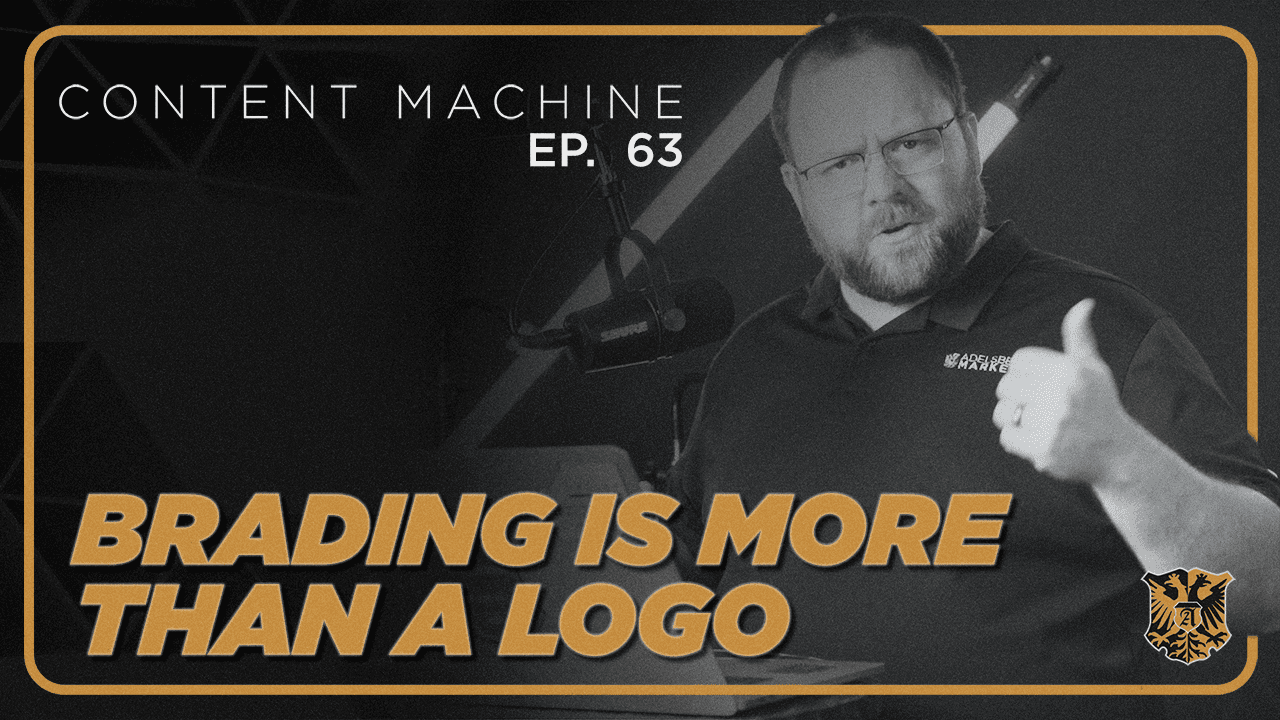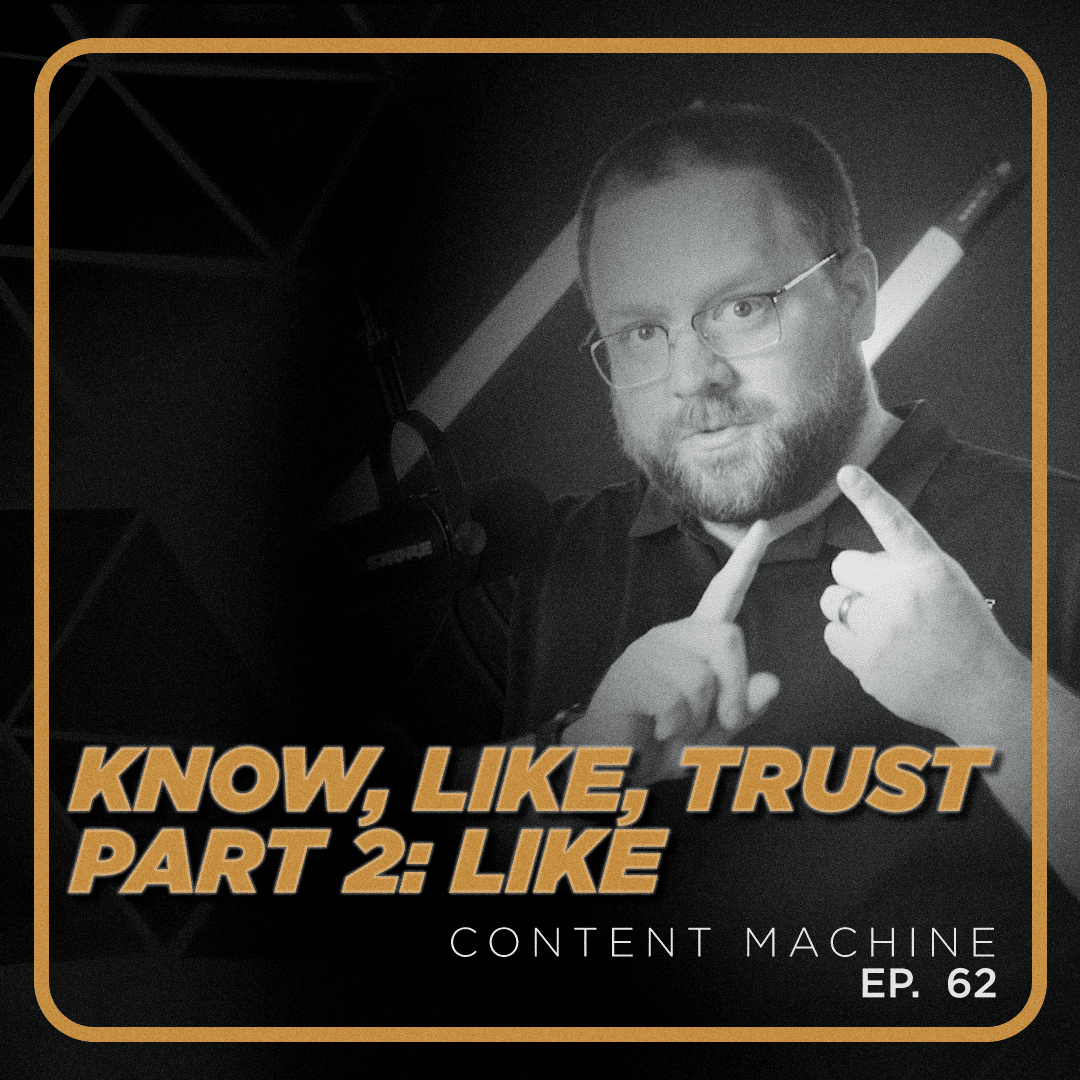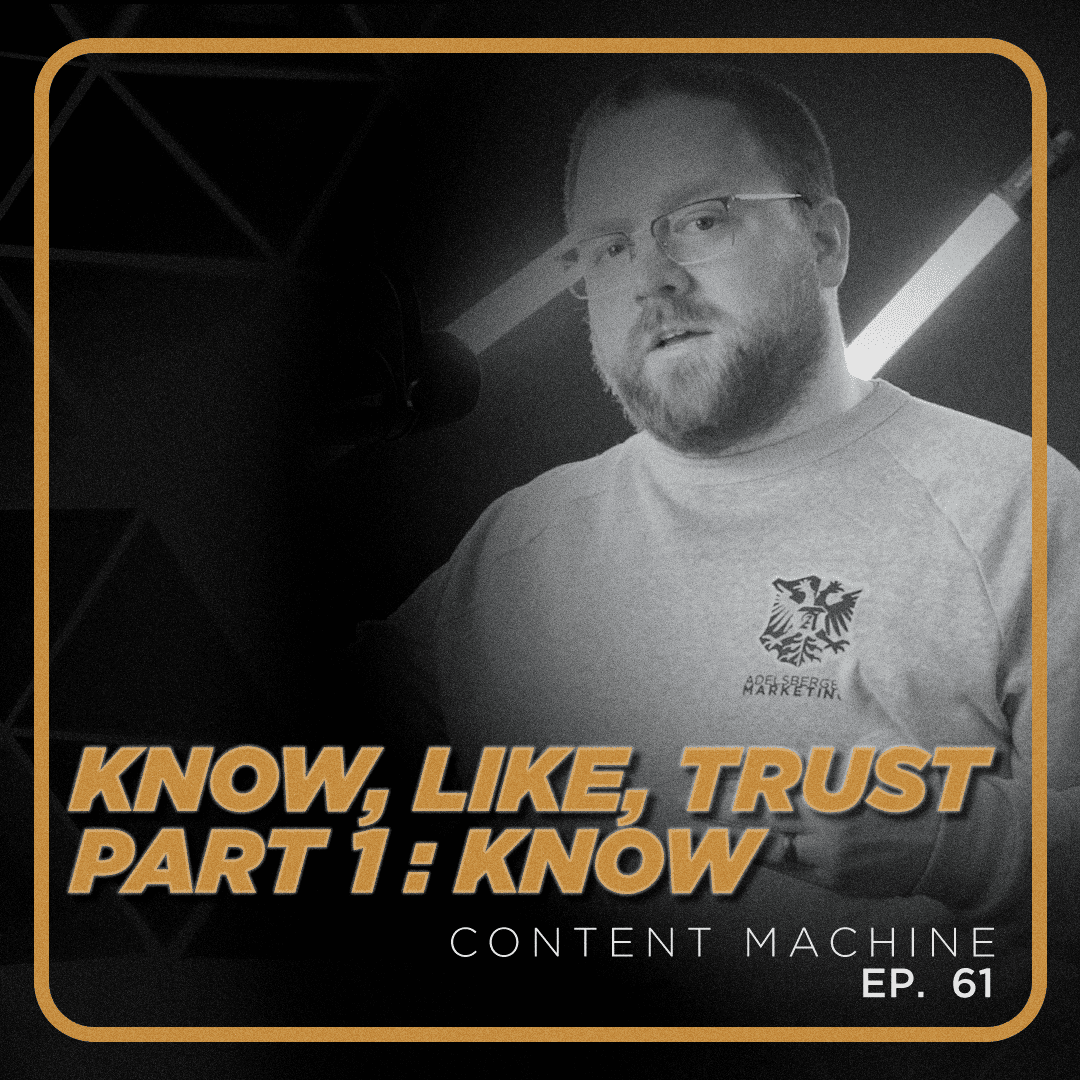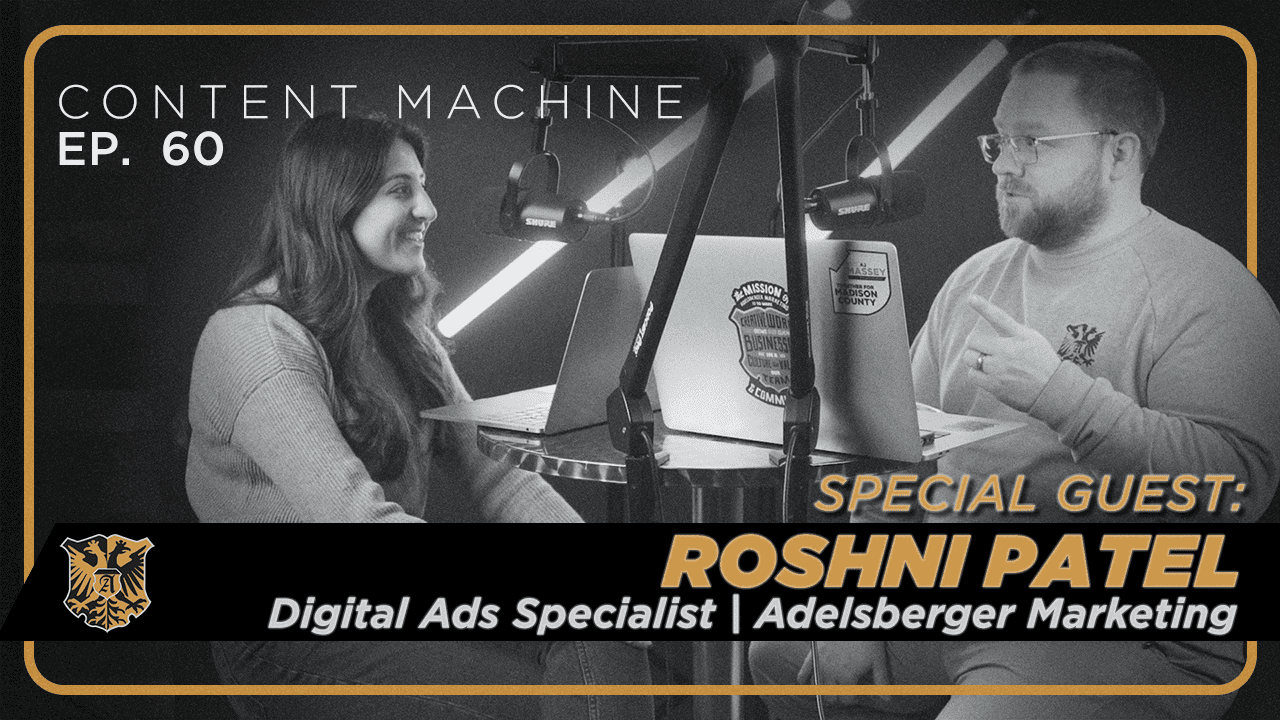Amy Garner Part 1 | Content Machine Ep. #64
Kevin
Welcome to the Content Machine podcast. I’m Kevin Adelsberger, and this week, I’m joined by Amy Garner, who is the Chief Compliance and Communications Officer at West Tennessee HealthCare. Thank you for joining me, Amy.
Amy
Thank you for having me.
Kevin
Amy, you have a really unique journey in your career, and I’d love for just the audience to hear starting about that. If you want to tell us a little bit about how you got to the position you’re in now.
Amy
Okay. Well, it’s probably going to be surprising to a lot of your listeners because I actually do not have a communications background. I actually have an accounting background. My undergraduate degree is in accounting. I have a master’s in business. I also have a law degree with an emphasis in health law. And then a few years ago, after I got the communications gig, I decided, well, I need to probably get some formal training in communications or public relations. I do have a certificate in public relations now. But my first love was math and accounting, of all things.
Kevin
Wow. Okay. So the first two make sense. The law degree is a little bit of an oddball there. How did you end up with a law degree?
Amy
So I was working in health care already, back in the late ’90s, and I knew that I wanted to further my education. I knew that I wanted to get a doctorate, but I didn’t want to get a PhD. So I wanted to do something with an advanced degree that would be useful at work. And obviously, I couldn’t just go back to medical school. So I decided that maybe health law might be of interest because of what I was doing at work already, because that was when the HIPAA privacy rules had just come out, and it was very useful to what I was doing. And so I thought, Well, that might be a good route for me to take. And so I ended up getting my law degree in health law.
Kevin
How about that. Did you spend any time as an accountant then?
Amy
Very briefly. I was in accounting for about four years after I joined West Tennessee HealthCare. And before that, I had actually worked in banking for a little while. But after I was in the role of the controller at one of our small hospitals, I decided that I really loved operations. I really did not want to sit in the office behind the computer and just deal with numbers all day. I really enjoyed getting out and learning from the different departments. And I was in such a small hospital, and they all just took me under their wings and taught me what they knew and what they thought I should know. And so I was able to learn all sorts of things from what happens in radiology to what happens in billing, to what happens in medical records on the nursing floor. So it was a great learning experience for me because I was so young and I just wanted to soak up everything. And so I think that that’s what led me into being the candidate for the compliance officer’s job, because you have to know a little bit about privacy. You had to know a little bit about the rules that the emergency department has.
Amy
You have to know about billing and Medicare. And so I think that that’s what led me to the place where somebody said, Hey, she might be a good compliance officer.
Kevin
So a lot of times when people hear the words Compliance Officer, nothing fun comes to mind. And all of my interactions with you, you don’t come off as a Compliance Officer to me. You have a little bit more fun than that. So what do you do as a Compliance Officer?
Amy
Well, I have to say that I’ve heard that before. It is not the most popular position to be in. And for a long time, I thought, this is the most thankless job because nobody wants to see you coming, right? Sure. And nobody wants to come to your office to tell on themselves or ride anybody else out. But I try not to be scary, and I’ve done this for so long now that I really think being in communications has helped me because people know who I am, and they know that I’m not necessarily the police. And so I think that from that perspective, you’re probably right. I am probably not the typical compliance officer, but I want to be a resource for people. And I was just sharing with somebody earlier this morning that my favorite part of my job is answering questions. As strange as that sounds, I love being able to answer people’s questions or to help them figure out where to go to get the answers that they need. And so I think that from that perspective, I try to be a resource rather than just, Oh, hey, I got you. You’re not following this policy. And sometimes I have to do that, but I try not to be awful about it.
Kevin
So you worked your way up in the business side of things, which naturally progressed into the compliance thing with the law degree and stuff.
Amy
That’s right.
Kevin
Where does communications come into that, then?
Amy
So I joke all the time that the reason that I was asked to be in communications is because I like to talk too much. So there’s probably some truth to that. Sure. J.R, my CEO, as you know, J.R, he’s the type of guy that if he ask you to do him a favor, you cannot tell him no. You’re going to say, Sure. What do you need? And that’s exactly what happened. He asked me to temporarily work with the communications and marketing team seven years ago. And at the time, I said, J.R, I don’t know anything about marketing, communications. I’d had some limited experience when I was working on my master’s degree in marketing and communications, but nothing formal. And so I was really out of my element, but I was not going to tell J.R. no. Actually, after a few months of working with the phenomenal team that I have, I said, J.R, I love it. Please let me keep it. I love it so much. And it was, I guess, part of it was that it was not so rigid, like the compliance role, and I could have some fun with writing or with doing things like this that you can’t really do as a Chief Compliance Officer.
Amy
Sure. Yeah, yeah. So I loved it. And then who knew that there was going to be a global pandemic, and so at some point, I probably should have said, No, I’m not the one. But I just felt like when all my colleagues were struggling to take care of patients and doing all that they could do, I felt like, Well, this is one way that I can help them for sure, because I’m not a clinical person, and I didn’t really know what else I could do to help them during the pandemic. So I did what I was asked to do. Actually, when I was looking back at my Facebook memories today, this is my fourth anniversary of the night that J.R called me and said, I need for you to put together a press conference for tomorrow. I need the mayors to be there. I need Kim Tedford from the Department to be there. You all are going to coordinate this. And it was like 10 or 11 o’clock at night when he called. And I was freaking out because unbeknownst to him, I had never coordinated a press conference before. I had never been a part of one, and I was clueless.
Amy
But he didn’t know that, and I didn’t tell him that at the time because I knew that no was not the right answer. And we pulled it off, and that was the beginning of all-
Kevin
Of a nightmare.
Amy
Yeah, it was the beginning of all of those media interviews and press conferences and all of those things that I did with Kim at the Health Department.
Kevin
Yeah. So you said seven years ago, you became communications. So that’s It’s March 11th, ’24, when we were recording this. So that would have been ’17, right?
Amy
That would have been 2020.
Kevin
It was four years ago. It was four years ago.
Amy
Yeah, ’17 is when I took on the role.
Kevin
So you had three years in the role before COVID struck and changed everything. So talk to us about how do you deal with communication when you’re newer into communication and you have a global pandemic ravaging your city?
Amy
I don’t know. I don’t really know that I have any great advice. I will tell you that the three years prior to the pandemic, one of the things on my to-do list was to develop a crisis communications plan, and I never put that down as a priority, and then I was living it. And so for me, it was just day to day, who do I need to communicate with? What are the messages that I need to get out there from my team? I was also having to learn all about operations and surge capacity and what it meant for us to have those portable HVAC units that were turning our units into… So that we had negative pressure rooms on those COVID floors. I mean, I was having to learn a lot, but my colleagues were great because when I asked questions, they were more than happy to share with me the information that I needed to get out there. And so in the morning, I would get up and I would follow social media to see if there was anything that I needed to address during the day, if there were any questions I needed to answer.
Amy
Then I would get on multiple calls with our incident command team, which is our emergency response teams, if you will. And I would learn what we were facing for the next 24 hours or 48 hours, what we had faced for the last 24 hours, what our COVID census was. Is there any specific information I need to get out to the public today? And then I would go through that process of whether it was a media interview, whether it was a press conference, whether it was a radio interview, whatever it was. I would try to get that information out. And then the rest of the day, I would pretty much monitor local news, social media, respond to questions. It was just a constant cycle. And I call it on the job training because I really did not know what I needed to be doing that I wasn’t doing. I just tried to keep up with everything and tried to figure out how to get information out to everybody, not just Madison County, but I had people contacting us from Haywood County or Chester County or Gibson County saying, Hey, what about us? What are you seeing in our counties?
Amy
What can we do? Can you come over here and talk with our mayor? And so there was a lot of that, too. So it was just… I just was doing whatever I could to get information out there. Yeah.
Kevin
Well, and I’d say as a citizen, I felt like it was really organized and went from my perspective, you guys were proactive and communicated well in a really stressful time period.. Thank you for tuning in to episode one of two with Amy Garner from West Tennessee HealthCare. Join us back in a couple of weeks when we release episode two of the interview.
Branding is More Than a Logo | Content Machine Ep. #63
When you say you like a company’s brand, what do you mean? Most people, when they say brand, they mean the logo of a company. Don’t get me wrong, a logo is an important part of a company’s brand, but a brand is so much more. We believe brand encompasses four key areas. Each of these areas is sizable and has lots of opportunities for subsets of information. But today, we’re going to look at things from a bird’s-eye view. We believe a brand encompasses the business’s identity, the business’s positioning, the business’s messaging, and the business’s visual identity. Let’s take a look at each of these elements. Number one, the business’s identity. The first part of any brand is who the business is. What is the business’s mission and core values? What is the business trying to achieve? The mission talks to the bigger picture that the company is trying to solve and what they value. The core values gives the team guidance on what behavior is valued in the organization. It will direct how components of the business interact with customers, how the business interacts with the team. It will set the tone for what the culture in the organization is.
Business identity is a key component of what makes the brand of an organization and gains importance as the business puts value on the identity, making it part of the culture and potentially part of the marketing. The second part of the brand is the positioning of the business. Positioning talks about what a business brings to market and how it goes to market. Or to put another way, what differentiates it from other businesses. When we think about what a business brings to market, what we mean is, how do we make something not a commodity? What makes our product special versus our competition? How we bring it to market might also be our differentiation. Are you the only car wash in town that comes to people’s workplaces? Are you an insurance agency that has the most available markets? Are you the largest organic and natural food provider in the area? How you bring something to market and the positioning that you use are key parts of the identity. The third part of the branding is messaging. This could be viewed as the verbal identity of the business. How do we describe the organizations? Do we have specific words that we use?
What is our marketing one-liner to quickly share who we are? This also works into the tone of how we write copy for the business. The fourth part, and the one that people think the most about when they talk about branding is the visual identity. The logo is the most important part of the visual identity of the business, but there are also several other components to visual identity. One of the biggest things is what we call look and feel. Look and feel for a brand is the visual style for graphics and things like websites. They give us a uniformed visual appearance across all interaction points for a customer. A social media graphic should be able to be visually related to the website, which should be visually related to the business card. This unified visual identity is usually tied together by specific colors, typefaces, textures, or graphical elements like certain shapes or icons. A proper visual branding contains these components and a guide with all the rules on how use the visual branding. Is your business using all the elements of a brand, or do you just have a logo? Today is a great day to start developing the other elements of your brand.
A great thing is to look at companies that do branding well and start to look for all of those components and how they use them. When you start looking for them, you’re going to notice them. Thank you for listening to this episode of the Content Machine podcast. If you need help developing a brand or rebranding your company, please reach out to me at kevin@adelsbergermarketing.com.
Know Like Trust Part 2 | Content Machine Ep. #62
Know, Like, Trust | Content Machine Ep. #61
When thinking about the customer acquisition journey, it can sometimes be a mystery how people decided to do business with you. Sometimes people describe it as a funnel. The more people hear about you, the more it’ll filter down to the people who turn into customers. And that’s a pretty good model. But a slightly different take on that, and a bit more of a relational take, is the know, like, and trust model. The know in the know, like, trust model means for someone to do business with you, they have to know who you are, they have to decide that they like you, and ultimately, they have to decide to trust you. Once they’ve decided they trust you, they will be willing to sign on the dotted line. This week we’re going to talk about the know, and then in future weeks, we’ll talk about like and trust. In the know like trust model, what does it mean to know? Very simply, it’s I know who you are or that you exist. So how do we become known? Two big thoughts, inbound and outbound marketing. Let’s start with outbound. Outbound marketing is anything that you are doing to actively get your name out there.
That might be sponsoring a local event, buying digital ads, or having a logo on the side of your truck. Outbound marketing is great for introducing yourself to people that might not know who you are or bringing you back to the top of people’s minds. Inbound marketing is when people come looking for you. It’s the experience they have on your website. It’s the content they see on your Facebook page when they come and look for you. I call inbound marketing being ready to be found. The biggest way inbound works into the no category is through things like social media and having good search engine results. We’ll talk more about inbound marketing when we talk about getting someone to like and trust you. But for now, know that if you invest in outbound marketing but do not have inbound ready to go, you are wasting your money. You have to be ready to be found, which is where steps between know and like start to bleed over. So what should we think about for outbound? One, audience, two, cost, three, brand image. When we think about audiences, we need to consider, are these the people we want to talk to?
So who do you want to talk to? Are they potential customers or are they referrers of potential customers? Are they just general potential customers? Or are they the target market that you really want to develop? Cost. Can you afford to do this? What do you think the ROI will be? Is it a one-time expense or an ongoing expense? Spending $1,000 to talk to 10 of the right people might make a ton of sense for your business. Spending the money to wrap your van might make sense, too. The cost varies by the audience and your business goals. And then finally, does this opportunity fit your brand? Even if an opportunity is with potential customers and affordable, does it make sense to align yourselves with that opportunity? This question could mean a variety of things for your brand, but things like the type of the event, the cause of the organization, or the message that the platform carries could have an effect. An example of this would be Adelsberger Marketing advertising in a traditional print newspaper. It would be an odd place to see us for a number of reasons, and it wouldn’t be a good fit.
We’ll talk more about know, like and trust in upcoming weeks. And so you need to ask yourself, are you ready to be found? Are you ready to start that relationship with a new customer? If not, send me an email at kevin@adelsbergermarketing.com and subscribe for future episodes of the Content Machine podcast.
Know, Like, Trust | Content Machine Ep. #61
Roshni | Content Machine Ep. #60
Kevin
Welcome back to the Content Machine podcast. This week, we are joined by Roshni Patel. Roshni is the digital ad specialist here at Adelsberger Marketing, and hopefully, she will be helping us learn a few things about digital advertising that will help you in your business. Roshni, thanks for joining us.
Roshni
Thanks for having me.
Kevin
So a commonly asked question we get, Roshni is, is it better to put ads on every platform or just a few?
Roshni
Just a few. Knowing where your audience is coming from is really important, so you’re not just spending money unnecessarily. Helping determine that means you might put your ad out on fewer platforms, but you’re getting a better cost per click result.
Kevin
All right. So using this, using any of these digital advertising platforms, are there ways to filter down to that audience to see, to the people you want to see to show your ads to?
Roshni
Yes. So most platforms allow you to choose an age demographic as as well as geographical demographic. So you can narrow down who’s seeing your ads. But a lot of platforms, such as Facebook, will allow you to target ads to people who have similar interests of your business or have liked your page or interacted with your page. Therefore, you’re being more cost-effective when showing your ad.
Kevin
Okay, very good. Yeah. And a lot of that starts with understanding who your customer is, right? Yes. So that’s a key part to when we start an ad project, we want to make sure we understand who that company’s customers are.
Roshni
Exactly.
Kevin
And then we can target ads to them. There might be a a few options of platforms that target customer that we were just talking about. Is there any ad format on those platforms that you think should be utilized more?
Roshni
Yes. So in recent years, video ads have become very popular. They’re very cost-effective, but they also keep the audience engaged. So short 15 to 30 second videos are really effective. So you can create short copy for them, but really, you just want to get your main points across in that short video.
Kevin
And should you always use video or can you use graphics as well? And if you can use graphics, do you have any tips on that?
Roshni
Yes. Graphic ads are also very effective, and especially depending on who you’re trying to engage as your audience. Platforms like Facebook, it’s really smart to use very clear and concise graphics and have more information in your copy. So you want to make sure the picture is engaging but easy to read. Also creating multiple variations of that copy with the graphic is really helpful because that way the platform can see which works best against each other. So what copy is doing best out in the field as opposed to just having the one ad.
Kevin
Okay. Yeah. So when we come to the table, frequently we bring multiple versions of a graphic so that we can make sure that we’re getting the best return on the customer’s ad spend. Yeah. And then a common question we get is about how much should we spend on digital advertising, or why is my cost so click so high? And what has been your experience with that?
Roshni
So cost per click can vary depending on the customer and where they’re located as well as what their competition is. So a big factor is competition in your area. If you are a local business, for example, like a plumbing and HVAC company, you might have more competition. Therefore, your cost per click will be higher because you’re fighting to appear in those ads, in the ad space. Another really important role is your ranking. And so ranking is determined in large part by your SEO. So that’s search engine optimization. Having a high SEO ranking will help you appear faster when you’re bidding for those ads. You can also, when doing Google Ads, for example, you can put a bidding increment in there, which means that’s how much you’re willing to spend when you’re trying to appear in those ads. It doesn’t mean Google will use all that money, but it just shows how far you’re willing to go to appear, which is really helpful.
Kevin
Yeah. So you might be able to say up to a dollar per click. And if the bid goes up to 65 cents, that’s what you’ll get charged. Yes, exactly. But you’re willing to maybe spend more than the other competitors. More, if maybe. That’s right. Now, sometimes when you’re looking at Google Pay Per Click or other types of pay-per-click advertising, keywords are important. Can you tell us about what keywords are and how do they work?
Roshni
So keywords are basically phrases or words that describe your business. They’re really important because keywords help determine where your ad appears. So for example, in a search ad, if someone’s searching plumber near me, having the keyword plumber in your ad, or in your keywords, excuse me, will help your ad appear. And it also helps narrow what is shown. So if someone’s searching for a painter, a plumber won’t appear. So you’re not wasting money. Keywords should be a shorter list and more detailed rather than a longer list of just a bunch of words, because you really want to narrow what your company does and what you’re hoping to promote or sell.
Kevin
And a lot of times with keywords, one thing that we’ve seen a lot is that sometimes the meaning that you think you have for the keyword is not the meaning that the searchers are having for the keyword.
Roshni
Yes, sometimes those words are a little skewed. Yeah.
Kevin
So you got to be careful to think about ulterior meanings or if the meaning of the niche of that word may not be what you’re trying to sell is another factor to consider. Well, Roshni, thank you for your time in joining us on the episode today. If you need help with digital advertising, please get in touch with us. Send me an email at kevin@adelsbergermarketing.com, and then hit subscribe on this episode so that you can get notified of future episodes that are coming out. And we’ll see you on the next episode of The Content Machine podcast.
Roshni | Content Machine Ep. #60
Google Business | Content Machine Ep. #59
Google Business | Content Machine Ep. #59
The biggest SEO tip we have for local businesses, make sure your Google business profile is ready to go. So what is a Google business profile and how do we optimize it? Let’s talk about it. You may have heard it called a Google My Business Profile, which is its previous name. In a nutshell, a Google business profile is one of the listings people find on Google when they look for your business. When you Google a local business on the Google Results page, you will likely see three things. One, potentially ads running for that business or for a competitor. Two, search results that hopefully show that local business, and a Google Business Profile. That Google Business Profile is Google’s effort to make sure that the business is listed correctly on Google. When people talk about search engine optimization or SEO, they are mostly meaning on Google and not necessarily other channels like Bing or Yahoo. This means that when we think about SEO, we need to think about what does Google care about. Well, using the tools that Google develops is a great way to do the things that Google cares about. All of this is why if you are a local business and you have not secured or updated your Google business profile, you are making a huge mistake.
Let’s talk about how to claim it, and if you’ve already claimed it, some things you can do to optimize your profile. To claim your profile, search for your local business on Google. You might very well see a Google business listing for your business already locatable through a Google search, and you can go through the process of claiming that listing so that you can take control of the information. That will likely involve a phone call or a piece of mail coming to your business from Google. Google has been working to make the verification process harder, however, to keep businesses legit on Google business listings. So this may take a little bit longer than you might expect it would. It can also get way more complicated if you do not have a traditional business address. If you work under an assumed business name or you don’t receive mail at your address, it becomes more difficult to get verified. Google has been then implementing things like video references to help make sure that your entity is legit. Once you have claimed your business profile, be sure to take the time to fill out all of the relevant items recommended by Google.
The business category, contact information, and things like websites should be no brainers to fill out. The first thing you want to be careful about is selecting the right category of business, whether that be a physical business or a service area business. Physical location businesses are for businesses that serve clients at their location. Service areas are for businesses that go to customers’ homes or businesses to provide that service. It’s like the difference between a traditional dry cleaner and an HVAC repair shop. Traditional dry cleaners, you must drop off your clothing, so it’s a physical location. HVAC repair companies, they come to your home or they come to your business, which makes it a service area business. But to take it to the next level and improve your listing and your visibility in the Google ecosystem, add pictures to your profile, add videos, add updates, seek out customer reviews, and then fill out any additional categories that the Google business profile has options for that fits your business. We also offer this word of warning. Google business profiles can be very touchy. Google has a propensity to suspend accounts if they think for some reason the account is being spammed or being manipulated in a way that’s spammy.
To protect yourself from this, make changes slowly. Too many changes too quickly or significant changes like name or address can flag your account for review or even get it suspended. Even things that you might not think of can get you in trouble, like be careful of how many accounts you have attached to your profile. Less is better. Also, customer reviews are great, but don’t get fake reviews. Google is not very communicative about why it might suspend your profile. From our personal experience, a client’s profile was once suspended, and the best answer we got after talking with Google was that one of the client’s emails attached to the account was flagged as suspicious. Of course, there was no reason for this, but we are at the mercy of Google like we are most of the time. Fake reviews can come through incentivizing people with money or paying for bots or offering a trade for reviews. If Google becomes aware of any of these, they can and will suspend your profile or remove it altogether. Losing a Google business profile can be a significant damage to your business. Over time, the value of your profile grows as you gain more views and relevance in search engines.
Imagine the damage to your business if suddenly no one could find you on Google at all. A final note, we suggest making a task or at least an annual calendar reminder for maintenance on your Google business profile. At least once a year, you should revisit the profile to make sure that your hours are up to date and that you’ve interacted with reviews and that nothing significant has changed on the profile, and add some new photos. This will help keep the profile relevant and make Google happy. Aren’t we all just trying to make Google happy? And one more thing about hours. Recently, a Google search business conducted a study and found that open hours for certain businesses did affect their search engine results during their closed hours. Why is that? Well, likely because Google is looking to constantly improve the way their results are shown. If you’re looking for a pizza place at 10:00 PM on a Friday, why would you want to see listings for ones that close at 8:00? The world of Google is always changing. Are you paying attention? Or do you have a partner who is? If you don’t have a Google business profile set up, you might need to talk with a marketing agency.
We’d love to chat with you. Please reach out to me at kevin@adelsbergermarketing.com to get a conversation started today.

